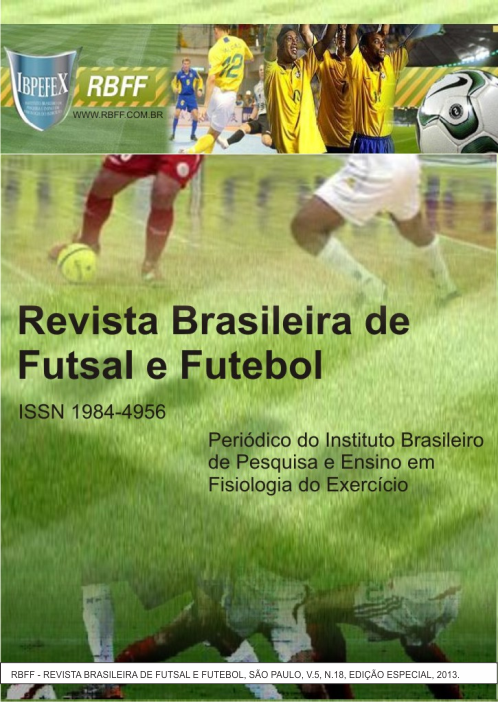Perception of student-athletes about the leadership style of teacher-coaches in Teresina-PI
Abstract
The purpose of this study was to investigate the perception of student-athletes on the leadership style of their teacher-coaches, through a quantitative descriptive research, which involved 129 adolescents (87 boys and 42 girls) aged between 11 and 17 years (x = 15.32 ± 1.54) enrolled in public and private schools of Teresina-PI competing at school level. For data collection a questionnaire was used to identify the sample and the "Leadership Scale for Sport -ELD" adapted from the Leadership Scale for Sport (LSS), Data analysis procedures were used descriptive statistics. When analyzed by gender, it was observed that 59.5% (n = 25) girls perceived more prominently the size scale training followed by positive feedback with 38.1% (n = 16). Since the dimension perceived most notably by the boys was the positive feedback with 47.1% (n = 41), followed by training dimension with 41.4% (n = 36). The size and extent of social support democratic behavior were perceived only by males as a percentage of8.0% (n = 7) and 3.5% (n = 3) respectively. As the size of autocratic behavior was only seen in females with 2.4% (n = 1). The student-athletes evaluated it was found that 47.3% (n = 61) most prominently realized dimension training, 5.4% (n = 7) the size social support, 44.2% (n = 57) to positive feedback scale, 2.3% (n = 3) the size democratic behavior and 0.8% (n = 1) the size autocratic behavior. The results in all analyzes indicate that the dimensions of training and positive feedback were predominant in the leadership styles of teachers, coaches Teresina-PI in the perception of student-athletes
References
-Ardua, C. M.; Márquez, S. Relação entre estilos de liderança do treinador e rendimento na natação sincronizada. Fitness & Performance Journal, Vol. 6. Núm. 6. p. 394-397. 2007.
-Barale, R. M. Adaptação da escala multidimensional de liderança no desporto –versão comportamentos atuais –para o contexto brasileiro de esportes coletivos. Dissertação Mestrado em Psicologia Aplicada. Instituto de Psicologia. Universidade Federal de Uberlândia. Uberlândia. 2009.
-Brandão, M. R. F.; Carchan, D. Comportamento preferido de liderança e sua influência no desempenho dos atletas. Motricidade. Vol. 6. Núm. 1. p. 53-69. 2010.
-Brasil. Lei de Diretrizes e Bases da Educação Nacional. Núm. 9. 394/96.
-Chelladurai, P.; Saleh, S. D. Preferred leadership in sports. Canadian Journal of Applied Sport Sciences. Vol. 5. p. 85-92. 1978.
-Dias, M. H.; Teixeira, M. A. P. Psicologia e jovens tenistas: Relato de uma experiência. Psico. Vol. 37. Núm. 2. p. 191-198; 2006.
-Gomes, A. R. S. Liderança e relação treinador atleta em contextos desportivos. Tese de Doutorado em Psicologia do Desporto. Instituto de Educação e Psicologia. Universidade do Minho. Braga. 2005.
-Lôbo, I. L. B.; Moraes, L. C. C. de A.; Nascimento, E. Processo de validação da escala de comportamento do treinador –versão atleta (ECT -A). Revista Brasileira de Educação Física e Esporte. Vol. 19. Núm.3. p. 255-265. 2005.
-Lopes, M.; Samulski, D.; Noce, F. Análise do perfil ideal do treinador de voleibol das seleções brasileiras juvenis. Revista Brasileira de Ciência e Movimento. Vol. 12. Núm. 2. p. 50-55. 2004.
-Noce, F. A importância dos processos psicossociais: um enfoque na liderança. Revista Brasileira de Psicologia do Esporte e do Exercício. Vol. 0. p. 55-67. 2006.
-Oliveira, R. D.; Brandão, M. R. F. Estilo de liderança dos professores/técnicos, sob a percepção dos atletas de basquetebol. Integração. Ano 15. Núm. 58. p. 225-233. 2009.
-Oshima, L. S. F. Treinamento esportivo na escola. TCC. Departamento de Educação Física da Faculdade de Ciências daUNESP. Universidade Estadual Paulista. Bauru. 2008.
-Pinho, S. T.; Alves, D. M.; Ramos Filho, L. A. O. In: XXIV Simpósio Nacional de Educação Física/II Seminário de Extensão. Anais. Pelotas: ESEF/UFPel, 2005.
-Pujals, C.; Vieira, L. F. Análise dos fatores psicológicos que interferem no comportamento dos atletas de futebol de campo. Revista da Educação Física. Vol. 13. Núm. 1. p. 89-97. 2002.
-Rubio, K. A Psicologia do esporte: histórico e áreas de atuação e pesquisa. Psicologia Ciência e Profissão. Vol. 19. Núm. 3. p. 60-79. 1999.
-Santos, P. B.; Fonseca, W. C. Um estudo sobre o estilo de liderança técnica preferido pelas jogadoras de vôlei. 2010. Disponível em: www.psicologia.pt/artigos/. Acesso em 19 de Novembro de 2011.
-Serpa, S.; Lacoste, P.; Antunes, I.; Pataco, V.; Santos, F. Metodologia de tradução e adaptação de um “teste específico do desporto”. A escala de liderança no desporto. In: II Simpósio Nacional de Investigação em Psicologia. Anais. Lisboa-Portugal. 1988.
-Simões, A. C.; Serassuelo Júnior, H.; Azevedo Júnior, L. C. D. Comportamento ideológico de liderança de professores-técnicos líderes de equipes esportivas escolares –modalidade basquetebol. Revista Brasileira de Cineantropometria & Desempenho Humano. Vol. 9. Núm. 1. p. 76-83. 2007.
-Sonoo, C. N.; Hoshino, E. F.; Vieira, L. F. Liderança esportiva: estudo da percepção de atletas e técnicos no contexto competitivo. Psicologia: Teoria e Prática. Vol. 10. Núm. 2. p. 68-82. 2008.
-Verardi, C. E. L. De Marco, A. Iniciação esportiva: a influência de pais, professores e técnicos. Arquivos em Movimento. Vol. 4. Núm. 2. p. 102-123. 2008.
Authors who publish in this journal agree to the following terms:
- Authors retain the copyright and grant the journal the right of first publication, with work simultaneously licensed under the Creative Commons Attribution License BY-NC which allows the sharing of the work with acknowledgment of the authorship of the work and initial publication in this journal.
- Authors are authorized to enter into additional contracts separately for non-exclusive distribution of the version of the work published in this journal (eg, publishing in institutional repository or book chapter), with acknowledgment of authorship and initial publication in this journal.
- Authors are allowed and encouraged to post and distribute their work online (eg, in institutional repositories or on their personal page) at any point before or during the editorial process, as this can bring about productive change as well as increase impact and impact. citation of published work (See The Effect of Free Access).





